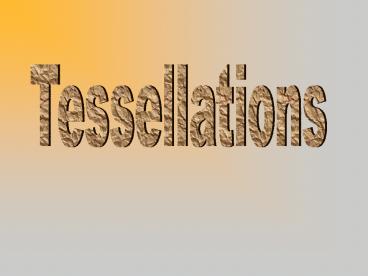Tessellations - PowerPoint PPT Presentation
1 / 32
Title:
Tessellations
Description:
Summary Regular Tessellation Only one regular polygon used to tile Semiregular Tessellation Uses more than one regular polygon Has the same pattern of polygons AT ... – PowerPoint PPT presentation
Number of Views:418
Avg rating:3.0/5.0
Title: Tessellations
1
Tessellations
2
Tessellation
- A tessellation or a tiling is a way to cover a
floor with shapes so that there is no overlapping
or gaps.
- Remember the last jigsaw puzzle piece you put
together? Well, that was a tessellation. The
shapes were just really weird.
3
Examples
- Brick walls are tessellations. The rectangular
face of each brick is a tile on the wall.
- Chess and checkers are played on a tiling. Each
colored square on the board is a tile, and the
board is an example of a periodic tiling.
4
Examples
- Mother nature is a great producer of tilings. The
honeycomb of a beehive is a periodic tiling by
hexagons.
- Each piece of dried mud in a mudflat is a tile.
This tiling doesn't have a regular, repeating
pattern. Every tile has a different shape. In
contrast, in our other examples there was just
one shape.
5
Alhambra
- The Alhambra, a Moor palace in Granada, Spain, is
one of todays finest examples of the
mathematical art of 13th century Islamic artists.
6
Tesselmania
- Motivated by what he experienced at Alhambra,
Maurits Cornelis Escher created many tilings.
7
Regular tiling
- To talk about the differences and similarities of
tilings it comes in handy to know some of the
terminology and rules.
- Well start with the simplest type of tiling,
called a regular tiling.It has three rules
- The tessellation must cover a plane with no gaps
or overlaps. - The tiles must be copies of one regular polygon.
- Each vertex must join another vertex.
- Can we tessellate using these game rules? Lets
see.
8
Regular tiling
- Tessellations with squares, the regular
quadrilateral, can obviously tile a plane.
- Note what happens at each vertex. The interior
angle of each square is 90º. If we sum the angles
around a vertex, we get 90º 90º 90º 90º
360º.
- How many squares to make 1 complete rotation?
9
Regular tiling
- Which other regular polygons do you think can
tile the plane?
10
Triangles
- Triangles?
- Yep!
- How many triangles to make 1 complete rotation?
- The interior angle of every equilateral triangle
is 60º. If we sum the angles around a vertex, we
get 60º 60º 60º 60º 60º 60º 360º
again!.
11
Pentagons
- Will pentagons work?
- The interior angle of a pentagon is 108º, and
108º 108º 108º 324º.
12
Hexagons
- Hexagons?
- The interior angle is 120º, and 120º 120º
120º 360º.
- How many hexagons to make 1 complete rotation?
13
Heptagons
- Heptagons? Octagons?
14
Regular tiling
- So, the only regular polygons that tessellate the
plane are triangles, squares and hexagons.
- That was an easy game. Lets make it a bit more
rewarding.
15
Semiregular tiling
- A semiregular tiling has the same game rules
except that now we can use more than one type of
regular polygon.
- To name a tessellation, work your way around one
vertex counting the number of sides of the
polygons that form the vertex.
- Go around the vertex such that the smallest
possible numbers appear first.
16
Semiregular tiling
- Here is another example made from three triangles
and two squares
- There are only 8 semiregular tessellations, and
weve now seen two of them the 4.6.12 and the
3.3.4.3.4
- Your in-class construction will help you find the
remaining 6 semiregular tessellations.
17
(No Transcript)
18
(No Transcript)
19
(No Transcript)
20
(No Transcript)
21
(No Transcript)
22
(No Transcript)
23
(No Transcript)
24
(No Transcript)
25
Demiregular tiling
- The 3 regular tessellations (by equilateral
triangles, by squares, and by regular hexagons)
and the 8 semiregular tessellations you just
found are called 1-uniform tilings because all
the vertices are identical.
- If the arrangement at each vertex in a
tessellation of regular polygons is not the same,
then the tessellation is called a demiregular
tessellation.
- If there are two different types of vertices, the
tiling is called 2-uniform. If there are three
different types of vertices, the tiling is called
3-uniform.
26
Examples
- There are 20 different 2-uniform tessellations of
regular polygons.
3.4.6.4 / 4.6.12
3.3.3.3.3.3 / 3.3.3.4.4 / 3.3.4.3.4
27
Summary
- Regular Tessellation
- Only one regular polygon used to tile
- Semiregular Tessellation
- Uses more than one regular polygon
- Has the same pattern of polygons AT EVERY VERTEX
- Demiregular Tessellation
- Uses more than one regular polygon
- Has DIFFERENT patterns of polygons used at
vertices - Must name all different patterns.
28
Name the Tessellation
Regular? SemiRegular? DemiRegular?
SemiRegular 4.6.12
29
Name the Tessellation
Regular? SemiRegular? DemiRegular?
Demiregular 3.12.12/3.4.3.12
30
Name the Tessellation
Regular? SemiRegular? DemiRegular?
Demiregular 3.3.3.3.3.3/3.3.4.12
31
Name the Tessellation
Regular? SemiRegular? DemiRegular?
DemiRegular 3.6.3.6/3.3.6.6
32
Name the Tessellation
Regular? SemiRegular? DemiRegular?
SemiRegular 3.3.4.3.4































